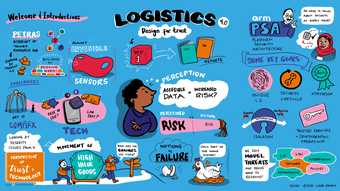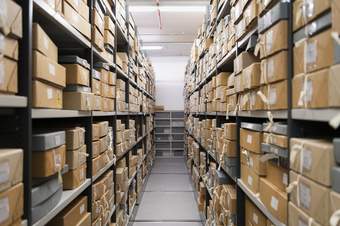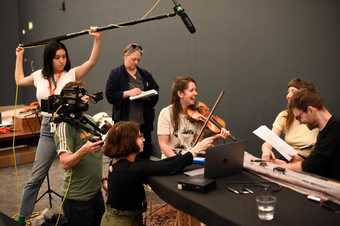
Key themes from the project’s first workshop, Design for Trust, November 2020
Illustration by www.laurasorvala.com
Tate’s collection is constantly on the move. Works of art are transported between Tate’s galleries and storage or conservation sites, and pieces regularly loaned to other institutions all over the world. This research project aims to advance Internet of Things (IoT) technologies to protect and monitor artworks, providing unprecedented volumes of data, transit behaviours and secure wide-area, real-time location control.
In addition to tracking works of art, this technology has the potential to enable Tate staff to intervene when pre-set conditions are breached: for example, if the temperature becomes too high, the humidity too low, or a shock is registered. Using a sense-and-respond feedback approach, these devices will non-intrusively protect objects but, moreover, can protect themselves from security risks.
While on display or in storage, there must be a high level of tracking precision as the work has to be located to a particular position inside a building. Tracking while in transit might not require such high accuracy but must still distinguish whether the object is on or off a truck or aeroplane. Tracked objects are often subject to security checks as they cross international borders and, while airborne, the tracking system needs to comply with additional regulations.
Currently there is no system that can provide unobtrusive, near real-time tracking of high-value objects where there must be absolutely no risk of the object being damaged, tampered with or stolen. Current tracking systems are susceptible to hacking and physical tampering. The broad area of security vulnerabilities for high-value tracking systems has yet to be fully mapped and studied, let alone solved.
Further challenges are caused by the nature of the objects being monitored. The device must not damage the work of art, either visually or chemically (for example, through use of an adhesive or material that might react with the substate of the artwork), and therefore needs to be small and unobtrusive. Tate’s collection incorporates an extraordinary range of materials and varies from large paintings and sculpture, to photographs, sketchbooks, film and video, to installations with hundreds or more individual components. How will trackers manage a work of art that, for example, consists of millions of porcelain sunflower seeds?

Ai Weiwei
Sunflower Seeds (2010)
Tate
Given the complex and demanding set of criteria involved in using art objects as the project test case, once the system has been developed, it will be of great value to a wide range of other industries and environments where there must be zero tolerance for risk; for example, to ensure that goods in the pharmaceutical or aviation industries are delivered untampered.
The project partners are Imperial College London (Project Lead), Tate (Co-Investigator), with additional support from Ordnance Survey, Arm Holdings and the fine art shippers Constantine and Momart, and insurers Blackwall Green, all of whom are bringing their considerable expertise to inform the research.
The project team has evolved from an already strong partnership, having successfully delivered two previous projects: Things D’Art and Art Connect. This new team widens the skillset and uniquely brings together technical practice from seven key areas: IoT device architectures, Sensor Signal processing, lightweight machine learning, IoT security, Geospatial Science, logistics and HVG management and protection.
This project has received support from Petras National Centre of Excellence for IoT Systems Cybersecurity.
Partners
Imperial College London
Professor Julie McCann, Head of AESE (Principal Investigator)
Michael Breza, Research Associate
Aisha Junejo, Research Associate
Tate Collection Management
Kate Parsons, Head of Collection Management (Co-Investigator)
Alyson Rolington, Registration Manager
With Support from Tate Research
Professor Pip Laurenson, Head of Collection Care Research
Jess Sully, Collection Care Research Manager
Kim Balukiewicz, Research Grants Manager
Industry Partners
Ordnance Survey
Jeremy Morley, Chief Geospatial Scientist
Stephen Hancock, Principal Scientist (GNSS)
Arm Holdings
Chris Adeniyi-Jones, Principal Research Engineer
Constantine Ltd
Paul Williamson, Director
Momart Ltd
Stuart Brown, Director
Additional Support from
Blackwall Green
Robert Graham, Director



